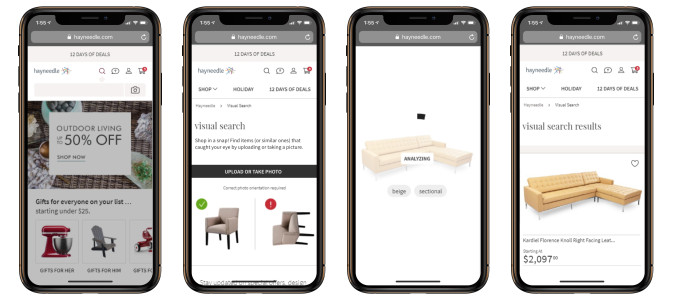Hayneedle, the home furnishings retailer that joined Walmart by way of an acquisition by Jet back in 2016, is now serving as the testing grounds for Walmart’s own in-house visual search technology. Built in collaboration between Hayneedle and Walmart Labs, the new technology has been slowly scaling up on Hayneedle over the course of the year.
Hayneedle had been offering visual search on its mobile app since 2017, but it was doing so through a partnership with third-party vendor Slyce.
To use the feature, customers take an image of a piece of furniture they like by snapping a photo in someone’s home or in a retail showroom, for example, or even taking a photo of a page in a magazine. The app then uses that image to find similar products from Hayneedle.com – much like how visual search works on other sites, like Pinterest or Google Shopping.
Walmart says it sees the potential in visual search because of how it can better guide customers to products, even when they don’t know what they’re looking for by name.
“We’re continually focused on improving the customer experience,” says Shelley Huff, Vice President of Home, Walmart U.S. eCommerce and President of Hayneedle. “And I think in the home industry that’s particularly challenging just with the breadth of offering of the products, and the fact that the majority of customers don’t really know what they’re looking for in terms of home furnishings. It requires, in many cases, a large level of inspiration,” she continues.
“If we look at how we can enable that shopping experience…and give them more confidence in their purchases and their ability to find products, visual search place and incredible role,” Huff says.
Visual search can also help the retailer with downstream effects, like reducing returns and boosting overall ratings for products, leading to more customer satisfaction with their purchases, she notes.
Walmart had been working on its own visual search technology before Hayneedle, but was having trouble launching it at Walmart’s scale. That’s where Hayneedle comes in.
After its acquisition by Jet, Hayneedle discovered there were a lot of technologies – including those in the realms of machine learning and A.I. – that it could take advantage of from Walmart and Walmart Labs. It could also launch these more quickly and easily because it’s a smaller organization from an engineering perspective.

In the case of visual search, Hayneedle partnered with a team at Walmart Labs, which worked on the backend machine learning pieces for the new platform. On its side, Hayneedle provided the site’s product catalog of over a million SKUs, and trained the system. It then integrated the visual search technology with its own site.
The relationship proved to be mutually beneficial, explains Hayneedle’s Head of Engineering, Benjamin Dekarske.
“We don’t have the dedicated core technologists that Walmart has with Labs, and Walmart gains from Hayneedle a platform [for visual search] that they don’t have to scale to Walmart’s scale – they can try it out at Hayneedle’s scale, then learn from and grow from there,” he says.
This was also the first time the Walmart Labs team worked with one of Walmart’s acquisitions, in terms of collaborating on the development of new technology together, rather than porting over technology from one place to another.
While visual search had already been in use at Hayneedle via Slyce, Hayneedle’s test of Walmart’s own visual search technology began this March.
It has since been running A/B tests between the two technologies to compare performance and results between the two, says Dekarske. The company continues to have an agreement with Slyce, but it has been shifting more of Hayneedle’s visual search results to its internally-sourced effort over time.
Walmart won’t say if it’s preparing to end its contract with Slyce, as a decision hasn’t been formally made.
Visual search is not the only technology Hayneedle is testing that’s meant to one day scale up to Walmart.com after testing on a smaller site. However, the others in the works are not necessarily customer-facing, and include efforts around customer profiling, segmentation, and those focused on improving operations.
This isn’t the only area where Walmart has visual search in use. The retailer just snapped up another e-commerce site, Art.com, that offers its own visual search technology.
It’s now preparing to look at Art.com’s implementation, the company says, to further refine its existing efforts.
